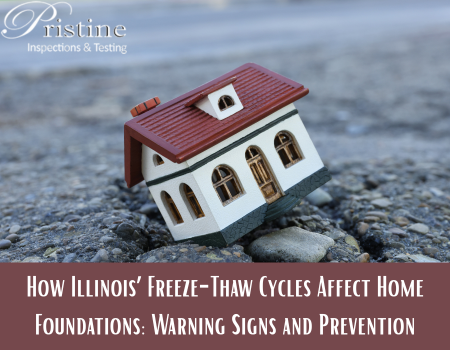If you live in Illinois or anywhere across the Midwest, you’ve likely seen firsthand how unpredictable winters can be. One week, temperatures drop below freezing; the next, there’s a sudden thaw. While this cycle may seem harmless on the surface, it’s quietly one of the biggest threats to your home’s foundation. The constant freezing and thawing of soil can cause cracks, shifts, and long-term structural damage that often go unnoticed until it’s too late.
Understanding how freeze-thaw home foundation damage occurs and how to prevent it can save Illinois homeowners thousands in repairs and ensure your property remains stable year-round.
How Freeze-Thaw Cycles Affect the Ground Beneath Your Home
When temperatures dip below freezing, the moisture in the soil surrounding your foundation turns to ice. As water freezes, it expands, pushing the soil upward and exerting pressure on the foundation walls. When temperatures rise again, the ice melts, and the soil contracts. This repeated cycle of expansion and contraction, known as the freeze-thaw effect, can gradually shift, crack, or weaken your home’s foundation.
Illinois, with its humid summers and icy winters, experiences this process more intensely than many other states. The region’s clay-heavy soil retains moisture, making it especially prone to expansion during freezes. Over time, this movement can lead to structural stress, uneven settling, and even basement leaks.
Common Warning Signs of Foundation Damage
Homeowners should routinely check for early indicators of Illinois foundation damage, especially during and after the winter months. Some of the most common signs include:
- Cracks in Foundation Walls or Floors
Small hairline cracks might not seem alarming, but if they widen over time, they could signal that your foundation is shifting due to freeze-thaw cycles. - Doors and Windows That Stick
When your foundation moves, your home’s frame can twist or settle unevenly. If doors or windows suddenly become difficult to open or close, it’s time for a closer look. - Uneven or Sloping Floors
A gradual tilt in your flooring is a strong indicator that your foundation is settling unevenly beneath the surface. - Basement Leaks or Dampness
Water seeping into your basement after a thaw suggests cracks or weak spots in your foundation walls. - Gaps Between Walls, Ceilings, and Trim
When you notice separation at the joints between walls or ceilings, it’s often due to structural shifts caused by soil movement below.
Preventing Freeze-Thaw Foundation Damage
While the Midwest’s climate is beyond your control, you can take proactive steps to protect your home from the effects of the freeze-thaw cycle. Here are some Midwest home inspection tips and preventive measures every homeowner should follow:
- Maintain Proper Drainage Around Your Home
Ensure your gutters, downspouts, and landscaping direct water away from your foundation. Poor drainage allows water to pool near your home, increasing the moisture content in the soil that freezes and expands. - Seal Foundation Cracks Early
Even small cracks can let in water that freezes and expands during cold weather. Sealing these cracks with waterproof epoxy or polyurethane can prevent bigger problems later. - Install a Sump Pump (If You Have a Basement)
A sump pump helps manage groundwater and prevents excess moisture buildup, especially during thaws when melting snow saturates the soil. - Keep Soil Moisture Consistent Year-Round
During dry spells, especially in summer, water the soil around your foundation lightly to prevent it from drying out and shrinking. This helps stabilize the ground and reduce movement when freeze-thaw cycles begin. - Insulate Basement or Crawl Space Walls
Adding insulation helps moderate temperature changes near your foundation, reducing the risk of sudden freezing and thawing in the soil directly adjacent to it. - Schedule Annual Foundation Inspections
Working with a professional who understands local soil conditions in Illinois ensures small issues are caught before they become major structural concerns.
The Role of Preventive Maintenance
Prevention is far more affordable than repair when it comes to foundation issues. Once the freeze-thaw cycle causes cracks or shifts, fixing them often involves costly excavation or structural reinforcement. Routine maintenance, such as inspecting your foundation every spring and fall, helps you spot trouble before it escalates.
Homeowners in the Champaign region and across Illinois should also take extra precautions during periods of heavy snow or rainfall. Clearing snow away from the perimeter of your home and ensuring proper grading around your property can go a long way toward preventing moisture buildup that leads to freeze-thaw expansion.
Final Thoughts
The freeze-thaw cycle is an unavoidable part of life in Illinois, but its effects on your home’s foundation don’t have to be. By understanding how it works, watching for early warning signs, and taking preventive measures, you can protect your investment and maintain your home’s long-term stability.
If you suspect foundation movement or moisture issues, consider consulting a professional familiar with Illinois foundation damage and Midwest home inspection tips. With the right attention and care, your home can stand strong no matter how many times the temperature swings from freezing to thawing and back again.

